|
HOME
- Introduction
- Monarchs & Monasteries
- Path to Royal Absolutism
Rise and Fall of the Absolute Monarchy -
From Empire to Democracy
Conclusion - Acknowledgments
 Monarchs
and Monasteries: Monarchs
and Monasteries:
Knowledge and Power in Medieval France
(late 8th -- late 15th centuries)
By the mid-eighth century when the Carolingian
family deposed the Merovingian dynasty, the king was more than a warlord,
he was also a religious figure, the Christian leader of his subjects,
the new chosen people. From the start, his dual role spawned a potent
mix of religion, politics, and culture.
Carolingian kings actively supported the study
of religious texts which prepared monks, the "soldiers of Christ," to
lead their people to salvation. Their courts served as important centers
for book collection, book production, and the dissemination of antique
culture throughout the West. However, it was abbeys and monasteries
that played the leading cultural role in the Carolingian kingdoms for
it was in their scriptoria that manuscripts were produced and
studied. Among the most famous were those at Saint-Denis, Corbie, and
Cluny.
The monastery of Saint-Denis' wealth and connections
with Italy made it one of the wellsprings of the Carolingian renaissance.
It also became the royal abbey and royal mausoleum, guarding the regalia
and the oriflamme, a crimson banner which accompanied the kings to battle.
Monks at the monastery of Corbie not only collected and copied books
but made their own contributions to the literature of theology, biography,
and polemic. In the eighth century, Corbie's scribes helped perfect
the clear script type known as the Carolingian minuscule. The abbey
of Cluny played a critical role in the monastic reform movement begun
in the tenth century, forming the hub of a network of European monasteries
where prayer, viewed as the remedy for sinfulness, took on ever increasing
importance.
During the twelfth and thirteenth centuries, French
power, culture and authority began to pass from rural monastic centers
to cities and the royal court. Paris became the artistic and commercial
hub of the kingdom, as well as its administrative and judicial center.
From the mid-thirteenth century through the sixteenth century, the "religion
of royalty" summarized by the motto "one king, one faith" (un roi,
une foi) reigned supreme in France. Royal religion was disseminated
through ceremonies and symbols preserved in manuscripts and in the artifacts
the kings commissioned.
Each royal ceremony was carefully staged and orchestrated
to impress those who witnessed it. The central ritual of the monarchy
was the installation ceremony at Rheims during which the king was anointed
with holy oil believed to endow him with the ability to heal a variety
of diseases. Other occasions, like royal marriages and ceremonies marking
the king's entry into a city, reinforced his authority which was symbolized
by his regalia: the ring, the spurs, the sword, the crown, the scepter,
and the hand of justice.
Early on, French kings understood that
they could derive great power and prestige from the written word, particularly
when it was embellished by magnificent illuminations. The potent impact
of these images, symbols, and texts on the people of France is evidenced
by the fury with which opponents of the monarchy and Catholicism--the
Huguenots in the sixteenth century, the Revolutionaries in the eighteenth--sought
to destroy them, as if they believed they could eradicate the power
of church and monarch by eliminating the material traces and representations
of their authority.
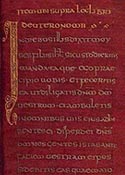 2.
Lectionary on Purple Vellum,
northern Italy, around 800. Manuscripts Department, Western Section,
Lat. 9451 Parchment 2.
Lectionary on Purple Vellum,
northern Italy, around 800. Manuscripts Department, Western Section,
Lat. 9451 Parchment
Lectionaries, which contained lections (readings from Scripture) to be read
at church services, figure among the most beautifully decorated manuscripts
of the early Middle Ages. Considered the image of the Divine Word, these
manuscripts were carried in church processions to the altar and then
to the pulpit, where the deacon conducted the reading. Gold, silver,
and purple symbolized the celestial kingdom, the reward of eternal life,
and the radiating splendor of God's Word.
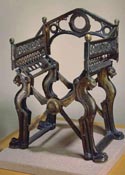 5.
Dagobert's Throne, France,
late 8th-9th century, Department of Coins, Medals and Antiquities, no.
651 5.
Dagobert's Throne, France,
late 8th-9th century, Department of Coins, Medals and Antiquities, no.
651
This is a plastic replica of the bronze armchair which belonged to the abbey
of Saint-Denis near Paris, and which was imaginatively attributed in
the Middle Ages to the Merovingian king, Dagobert I (623/9-639). In
the Middle Ages religious institutions maintained magnificent collections
of relics such as this throne. Such treasures provided a concrete expression
of the power of the Church and of the Monarchy, and could be melted
down or pawned for cash.
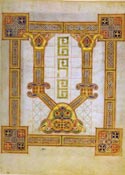 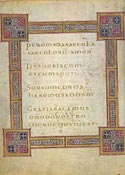 7.
Sacramentary--Use of Saint-Denis, second half of the 9th century,
Manuscripts Department, Western Section, Lat. 2290, Parchment 7.
Sacramentary--Use of Saint-Denis, second half of the 9th century,
Manuscripts Department, Western Section, Lat. 2290, Parchment
(Left page) - (Right
page)
The style of the rich ornamentation of this manuscript suggests that it was
prepared at the flourishing scriptorium of Saint-Amand-en-Pévèle
at the request of Charles the Bald (843-877) for his favorite abbey,
Saint-Denis. As was customary for Carolingian sacramentaries, only the
Preface and the Canon of the Mass are illustrated, in this case in the
very beautiful, purely ornamental style that marked the end of Carolingian
illumination.
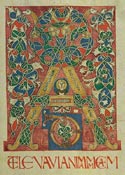 10.
Gradual--Use of Saint-Michel de Gaillac,
near Albi, before 1079. Manuscripts Department, Western Section, Lat.
766, Parchment 10.
Gradual--Use of Saint-Michel de Gaillac,
near Albi, before 1079. Manuscripts Department, Western Section, Lat.
766, Parchment
The Gradual was a basic book of the liturgy that originally contained the
chants of the Proper of the Mass. Remarkably decorative, embellished
with marvelously colored geometric designs and interlacing, this manuscript
exhibits a style that prevailed between 1050 and 1150 in France, from
Limoges to the Pyrenees and into Spain. Crucial to the history of music,
this Gradual contains elements of the Gallican chant used in Gaul before
the Gregorian reform of the eleventh century.
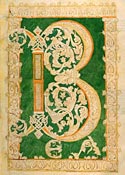 13.
Psalter-Hymnal of Saint-Germain-des-Prés,
Paris, middle of the 11th century. Manuscripts Department, Western Section,
Lat. 11550, Parchment 13.
Psalter-Hymnal of Saint-Germain-des-Prés,
Paris, middle of the 11th century. Manuscripts Department, Western Section,
Lat. 11550, Parchment
Founded by Clovis's son Childebert (511-558) in the sixth century, the Parisian
abbey of Saint-Germain-des-Prés was an influential intellectual
center up to the eighteenth century. The abbey's prosperity dates from
the eleventh century when it housed a flourishing scriptorium. This
Psalter-hymnal, with its decorative alphabet and sparing use of highlights,
is a brilliant example of Romanesque art from the Ile-de-France.
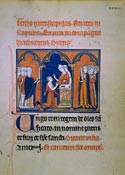 15.
Coronation Ordinal of 1250,
Paris, Manuscripts Department, Western Section, Lat. 1246, Parchment 15.
Coronation Ordinal of 1250,
Paris, Manuscripts Department, Western Section, Lat. 1246, Parchment
The fifteen miniatures of the Coronation Ordinal of 1250 present
the oldest known iconographic cycle showing the coronation of a French
king in the cathedral of Rheims, virtually as it would be staged until
1825. The archbishop of Rheims, assisted by the abbots of Saint-Remi
of Rheims and of Saint-Denis, officiated in the presence of the peers
of the realm. This manuscript was consulted for the coronations of Francis
I (1515) and Henry IV (1594).
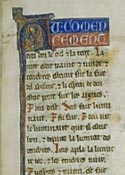 17.
French Bible of Acre, third
quarter of the 13th century, Library of the Arsenal, MS 5211 Rés.
Parchment 17.
French Bible of Acre, third
quarter of the 13th century, Library of the Arsenal, MS 5211 Rés.
Parchment
Copied around 1250-54, this Bible is probably the oldest and most beautiful
illuminated manuscript to come out of the Latin Kingdom of Jerusalem
which was founded in the aftermath of the first crusade (1096-1099).
Saint Louis probably commissioned this richly-decorated Bible on one
of his visits to Acre, a flourishing port on the Palestine coast, and,
after the loss of Jerusalem in 1187, the de facto capital of
the Latin Kingdom and the Patriarchal See.
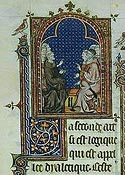 20.
Gossouin of Metz, Image du Monde (Picture
of the World), Paris, 14th century, Manuscripts Department,
Western Section, Fr. 574, Parchment 20.
Gossouin of Metz, Image du Monde (Picture
of the World), Paris, 14th century, Manuscripts Department,
Western Section, Fr. 574, Parchment
The Picture of the World apparently is the oldest encyclopedic treatise
written in a vernacular language. Composed in the dialect of Lorraine,
it was written in 1246 for Saint Louis's brother, Robert d'Artois (b.
1216-d. 1250), who wanted to know how the world had been "constructed."
The text is divided into three parts: God and human intelligence; nature
and the elements of the cosmos; and, physical phenomena and astronomy.
This opening depicts the arts of Logic, Rhetoric, and Arithmetic..23.
Guillaume de Saint-Pathus (active 1277-1315), Vie et miracles de Saint
Louis (Life and Miracles of Saint Louis), Paris, around 1330-1340, Manuscripts
Department, Western Section, Fr. 5716, Parchment
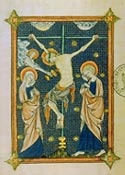 21.
Frère Laurent, La Somme le roi
(usually referred to as, The Book of Vices and Virtues),
northern France, early 14th century Library of the Arsenal, MS 6329.
Parchment 21.
Frère Laurent, La Somme le roi
(usually referred to as, The Book of Vices and Virtues),
northern France, early 14th century Library of the Arsenal, MS 6329.
Parchment
In 1279-80, at the request of King Philip the Bold (1270-1285), Friar Laurent,
the king's confessor, composed a manual of moral instruction known as
La Somme le roi. The author was inspired by earlier texts,
in particular a treatise on vices and virtues entitled the Miroir
du Monde (Mirror of the World). La Somme le roi was translated
into numerous languages and dialects and achieved a wide circulation.
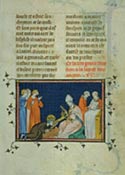 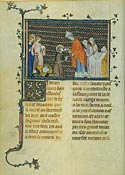 23.
Guillaume de Saint-Pathus (active 1277-1315), Vie et miracles de
Saint Louis (Life and Miracles of Saint Louis), Paris, around 1330-1340,
Manuscripts Department, Western Section, Fr. 5716, Parchment 23.
Guillaume de Saint-Pathus (active 1277-1315), Vie et miracles de
Saint Louis (Life and Miracles of Saint Louis), Paris, around 1330-1340,
Manuscripts Department, Western Section, Fr. 5716, Parchment
(Left page) - (Right page)
This account is the French translation of a Latin original, since lost, which
was used in the canonization proceedings of Louis IX (1226-1270). It
was composed for Blanche of France, Saint Louis's daughter. The manuscript's
ninety illustrations are divided into two series: the first relates
to the edifying actions of the king's life; the second consists of sixty-five
supplementary miniatures illustrating the miracles that occurred at
the sovereign's tomb in the Abbey of Saint-Denis.
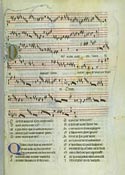 24.
Guillaume de Machaut (b. around 1300-d. 1377), Oeuvres (Works), Paris, around 1350-55,
Manuscripts Department, Western Section, Fr. 1586, Parchment 24.
Guillaume de Machaut (b. around 1300-d. 1377), Oeuvres (Works), Paris, around 1350-55,
Manuscripts Department, Western Section, Fr. 1586, Parchment
A poet and innovative composer, Guillaume de Machaut was a major figure in
fourteenth-century French literature and music. Apart from his celebrated
Coronation Mass, his art was essentially of secular inspiration and
found its most finished expression in a series of Dits (stories
in verse, interspersed with lyric and musical pieces). In them the author
celebrated the traditional themes of courtly love. This manuscript may
well have been intended for the royal family.
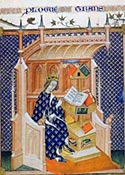 25.
Denis Foulechat, Translation of John of
Salisbury's Policraticus, Paris, 14th century, Manuscripts
Department, Western Section, Fr. 24287, Parchment 25.
Denis Foulechat, Translation of John of
Salisbury's Policraticus, Paris, 14th century, Manuscripts
Department, Western Section, Fr. 24287, Parchment
In 1372, Charles V (1364-1380) had Foulechat translate Policraticus,
an important medieval text about political theory which projected a
theocratic vision of the State and posed the question of monarchical
legitimacy and tyrannicide. This illustration depicts the wise king
Charles V seated on a chair from which justice was meted out and pointing
to the manuscript placed on a bookwheel. He is the very picture of the
learned and just king blessed by the hand of God.
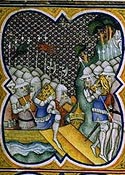 27.
Les Chroniques de France selon ce qu'elles
sont composées en l'église de Saint-Denis en France (The
Chronicles of France as Composed in the Church of Saint-Denis in France),
Paris, around 1370, Manuscripts Department, Western Section, Fr. 10135,
Parchment 27.
Les Chroniques de France selon ce qu'elles
sont composées en l'église de Saint-Denis en France (The
Chronicles of France as Composed in the Church of Saint-Denis in France),
Paris, around 1370, Manuscripts Department, Western Section, Fr. 10135,
Parchment
The manuscript on display contains the French-language version of the royal
chronicles up to the death of Philip VI of Valois in 1350, as they were
composed at the abbey of Saint-Denis. This volume was probably produced
around 1370 for Charles V. The four miniatures that make up the painting
at the beginning of the manuscript illustrate the key features of the
myth of the Trojan origins of the Franks.
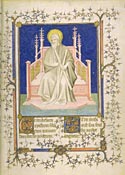 29.
Psalter of Jean de Berry, Bourges,
around 1386-1390, Manuscripts Department, Western Section, Fr. 13091,
Parchment 29.
Psalter of Jean de Berry, Bourges,
around 1386-1390, Manuscripts Department, Western Section, Fr. 13091,
Parchment
Jean de France, Duke of Berry (b. 1340-d. 1416), is associated with some of
the most beautiful illuminated manuscripts from the end of the Middle
Ages. The text of his celebrated Psalter is preceded by twenty-four
paintings in grisaille which constitute one of the most remarkable interpretations
of the Apostle's Creed, an extremely popular iconographic theme of the
period. The figures and their strongly individualized physiognomies
are the work of the sculptor André Beauneveu.
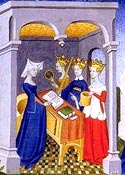 30.Christine
de Pisan (b. 1364-d. after 1429), Le Livre de la Cité des Dames (The Book of
the City of Women), Paris, around 1405, Manuscripts Department,
Western Section, Fr. 607, Parchment 30.Christine
de Pisan (b. 1364-d. after 1429), Le Livre de la Cité des Dames (The Book of
the City of Women), Paris, around 1405, Manuscripts Department,
Western Section, Fr. 607, Parchment
Christine de Pisan, the first female writer to earn a living from her pen,
defended the status of women. In this illustration, aided by Reason,
Uprightness, and Justice, she lays the foundation of a City exclusively
for women who have served the cause of women (female warriors, politicians,
good wives, lovers, and inventors, among others). The imagined City
will be crowned by the glory of the Virgin and sainted women.
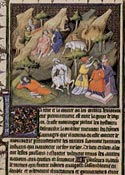 31.
Frère Hayton (b. around 1235-d. around 1314), Fleur des histoires de la terre d'Orient (Bouquet
of Stories from the Land of the Orient), Paris, 1403, Manuscripts
Department, Western Section, Fr. 12201, Parchment 31.
Frère Hayton (b. around 1235-d. around 1314), Fleur des histoires de la terre d'Orient (Bouquet
of Stories from the Land of the Orient), Paris, 1403, Manuscripts
Department, Western Section, Fr. 12201, Parchment
This manuscript belonged to the Duke of Burgundy, Philip the Bold
(b. 1342-d. 1404), and reflects the interest of the dukes of
Burgundy in Oriental matters. The text describes the victory in
1402 at Ankara of Tamerlane, khan of Mongolia, which temporarily
ended the Ottoman threat to Constantinople. The manuscript's
illumination reflects the Flemish influence that revitalized
Parisian painting at the beginning of the fifteenth century.
This folio depicts the coronation of Genghis Khan (b. 1162-d.
1227).
HOME
- Introduction
- Monarchs & Monasteries
- Path to Royal Absolutism
Rise and Fall of the Absolute Monarchy -
From Empire to Democracy
Conclusion - Acknowledgments
Library
of Congress Exhibitions - Library
of Congress Home Page
 Library
of Congress Library
of Congress
Contact Us (January 19, 2001)
|

